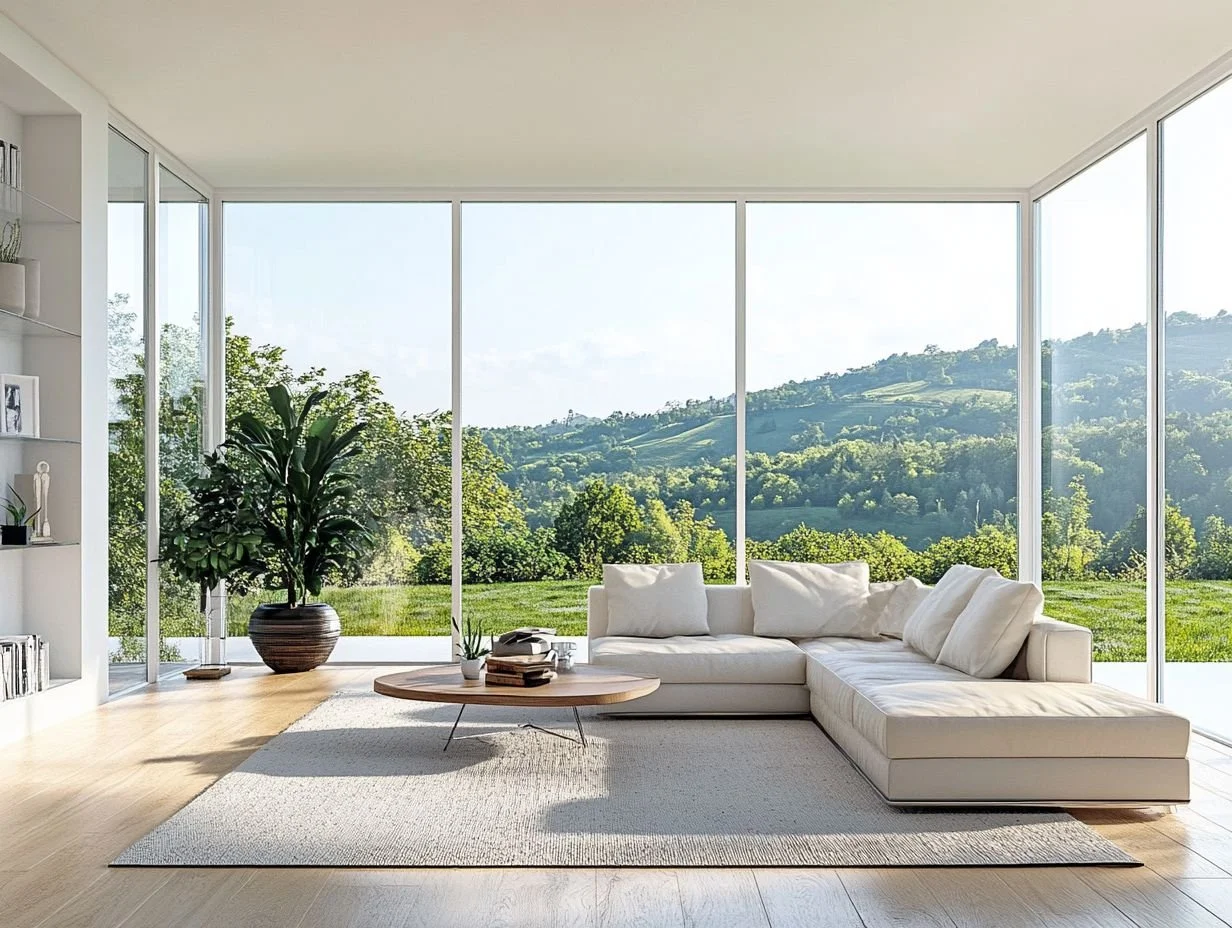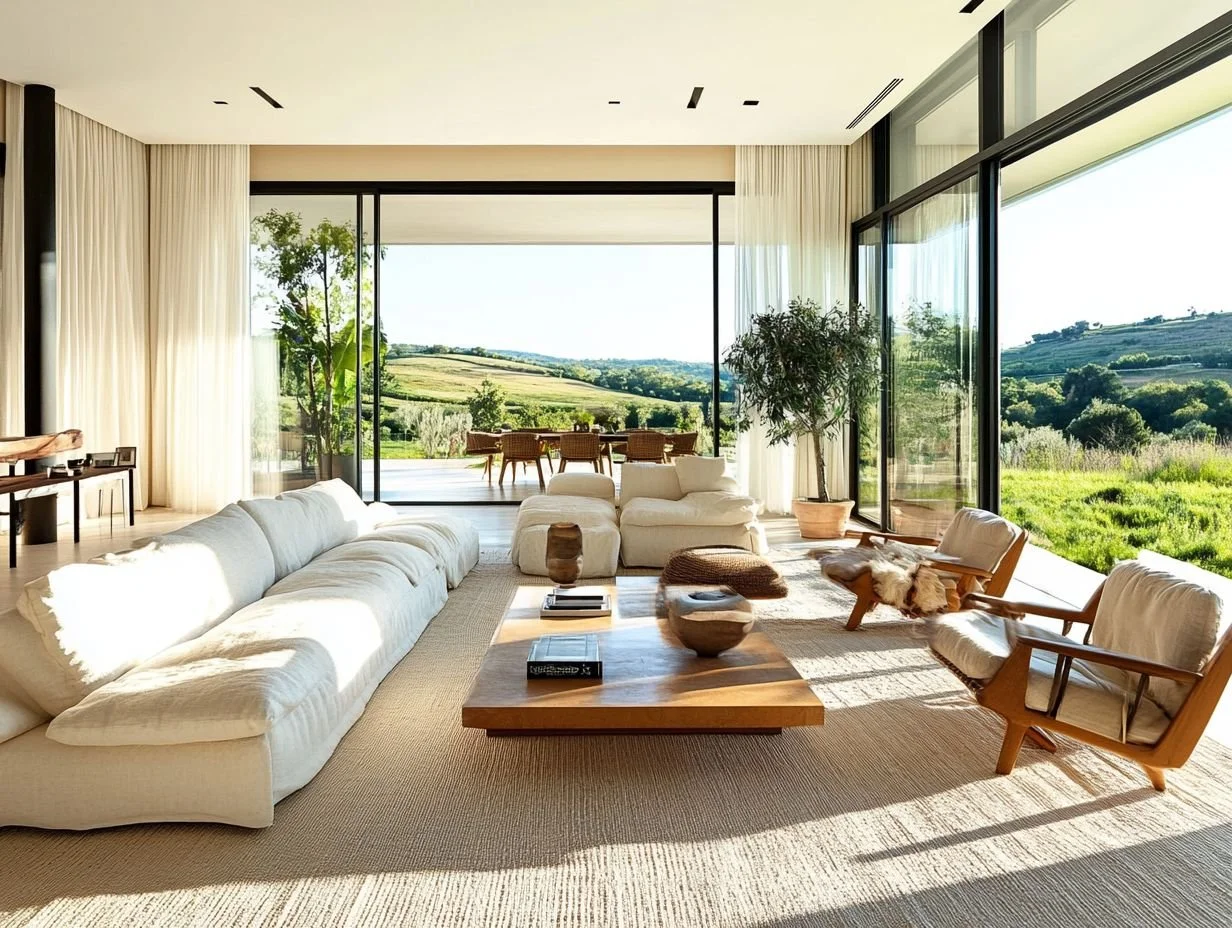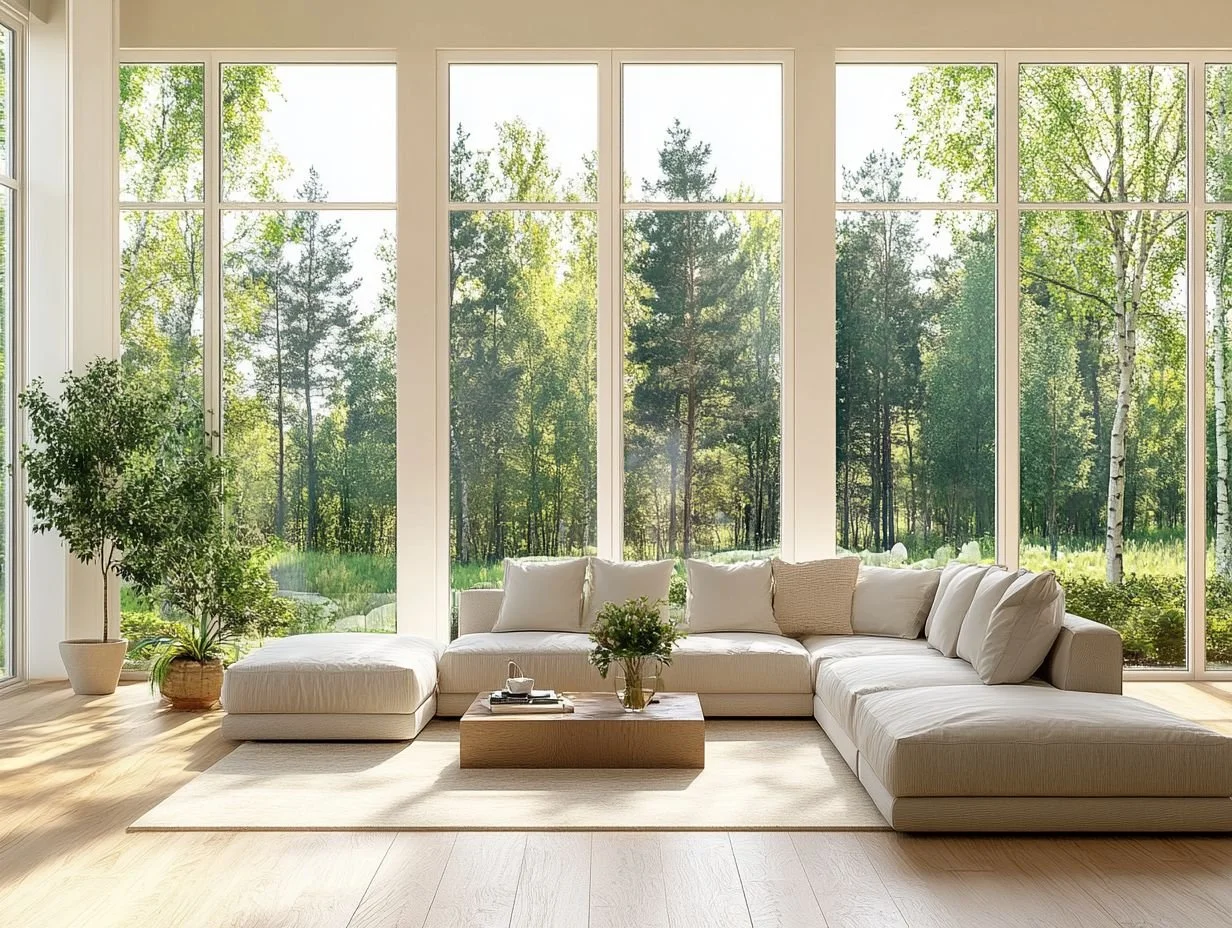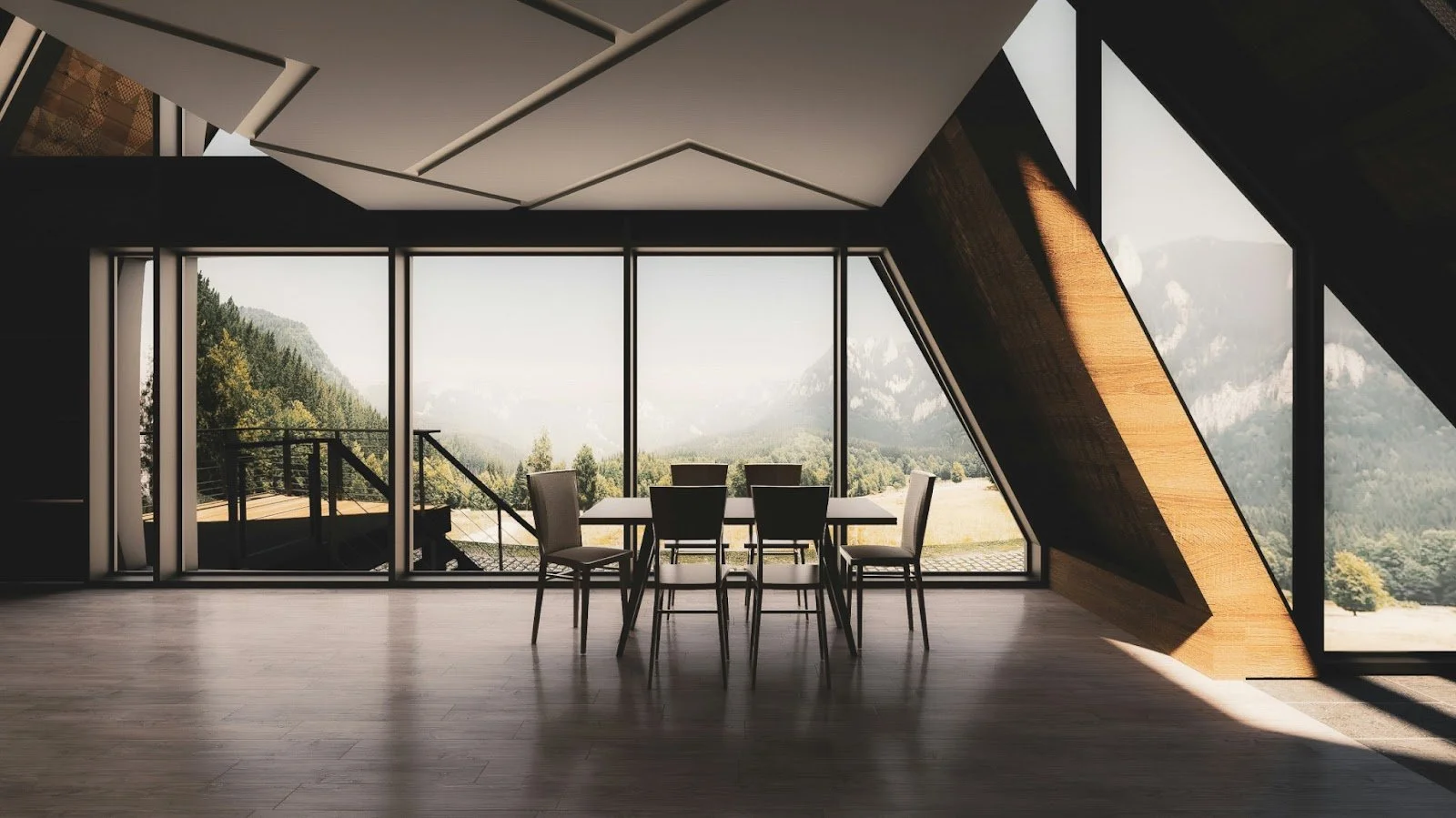Our Guide to Floor-to-Ceiling Windows for Interior Design
You enter a room with floor-to-ceiling windows. Natural light is flooding in.
Every corner is illuminated, and there are enchanting views all around you - perhaps street lights glinting, maybe mountains in the distance, or even a canopy of verdant trees.
The effect of floor to ceiling windows and expansive glass is alluring.
At High, Low, Buffalo, we find them just dreamy - which is precisely why we'd like to wax lyrical about how best to incorporate this design feature into your space.
Key Takeaways:
Floor-to-ceiling windows provide sunlight, expansive views, increased ventilation, and a seamless indoor-outdoor connection, enhancing the beauty of any space.
Along with aesthetic benefits, these windows are also energy efficient and can lead to improved mood and productivity, increased property value, and a unique design that enhances curb appeal.
When incorporating floor-to-ceiling windows in your home, consider location, privacy, window type, and window treatments, as well as regular maintenance, safety precautions, and protection against extreme weather.
The Beauty of Floor-to-Ceiling Windows for Your Home
There's a rare, unparalleled aesthetic appeal to floor-to-ceiling windows.
We love how they visually merge indoor and outdoor environments in a way that means you can watch the snowfall from the comfort of your own couch.
Another appealing feature is that they allow beautiful sunlight to flood living spaces - while at the same time offering unobstructed outdoor views that create depth and a sense of expansiveness.
These illuminating glass structures certainly bring a spot of magic to the visual joy of a home or office.
They also reflect a thoughtful integration of architectural styles that resonate with contemporary design trends and emphasize the importance of natural elements in indoor living.
What are Floor-to-Ceiling Windows?
Floor-to-ceiling windows are large window walls that stretch from the ground to the ceiling, creating a seamless transition between the interior and exterior of modern homes.
You've probably seen them before in office or coworking spaces, libraries, or in someone else's home.
Ample sunlight indoors is, of course, guaranteed. On top of that, floor-to-ceiling windows also contribute to a sense of spaciousness.
They really do make rooms feel larger and more inviting - and the views are to die for.
Different types of such expansive windows, including framed, frameless, and sliding variants, cater to different architectural needs and personal tastes.
These offer their own functional perks too.
Unlike standard-sized windows, which can impose limitations on views and daylight, floor-to-ceiling windows give a wide-angle panorama, which usually nourishes a space's palpable connection to nature - especially in mountainous, forest, or similar natural settings.
A cautionary tale - the initial installation costs can be quite high due to the extensive labor and materials required.
On the plus side, though, these windows can also be complemented with energy-efficient options that minimize heating and cooling costs in a way that really makes a dent.
For these reasons, we recommend that you aim for optimized designs that enhance energy efficiency and maximize the visual impact of these stunning windows.
How Do Floor-to-Ceiling Windows Enhance a Space?
The seamless indoor-outdoor connection of floor-to-ceiling windows is particularly beneficial, in urban living environments.
They're an interior design choice that leads to room expansion.
It’s always important to have a careful design approach, and this design choice of course elevates the aesthetic value of living spaces, and it even contributes to improved ventilation.
And if a harsh winter sets your mental health back a bit, it's worth knowing that these windows even reduce seasonal depression.
Several studies show that allowing sunlight to penetrate deep within the home also allows for plenty of vitamin D production.
Natural Light
Natural light is one of the most significant benefits of floor-to-ceiling windows.
They allow an abundance of sunlight to enter a home, improving the overall illumination and brightening the ambiance of indoor spaces.
Uniting the indoors and outdoors makes for an elevated mood and even better wellbeing.
Not to mention, exposure to natural light helps regulate circadian rhythms, which in turn improves sleep quality and even productivity.
That's why we at HLB so often recommend that office spaces and libraries capitalize on the wonderful perks of large windows.
A great example of a workspace that reaps the advantages of floor-to-ceiling windows is Bobst Library at NYU, for example, which looks out over the trees of Washington Square park.
This way, students cooped up during exam season are still getting plenty of sunlight.
Equally, a home bathed in the honeyed tones of rich, warm natural light feels more inviting, dozy, and spacious.
As for upkeep, energy-efficient windows, maintained curtains, and regular dusting can maximize this sunlight, ensuring that every corner of the room is rejuvenated.
Expansive Views
You can get a healthy serotonin dose from a beautiful, expansive view, which is precisely what floor-to-ceiling windows can provide.
With them, you can connect with the surrounding landscape, enhancing the curb appeal and overall aesthetic value of your property at the same time.
This visual connection fosters a profound sense of peace a lot of the time. It can also transform one's perception of space, creating an illusion of greater depth and tranquility.
Our pro tip is to consider integrating landscaping that complements these expansive views for the best results.
For instance, strategically placed trees or flower beds can frame the windows beautifully and bring more attention to them as a focal point.
Increased Ventilation
You may not guess it, but increased ventilation comes with floor-to-ceiling windows.
Perhaps one of the more surprising perks, this is because they can be designed to open easily, ensuring that indoor air quality is excellent.
That's in line with the way these windows make spaces feel more airy and spacious too.
This mechanism doubles as a way to reduce humidity levels, as fresh air flows in and dilutes any accumulated indoor pollutants.
Of course, without proper airflow, moisture can stagnate, leading to mold growth and other health hazards - and floor-to-ceiling windows are a gorgeous way to prevent that.
Energy-efficient windows are particularly effective in this way.
That's because they can enhance ventilation when opened and at the same time help maintain stable indoor temperatures.
As a result, you may well see your reliance on heating and cooling systems diminish.
Enchanting Indoor-Outdoor Connection
A seamless indoor-outdoor connection is really what defines floor-to-ceiling windows.
What's more, you can complement them with sliding glass doors or patio access, further blurring the boundary between indoor and outdoor living spaces.
It's through this blend that you can enhance the outdoor living experience, as patios and decks provide versatility and allow for all sorts of activities - from entertaining guests to enjoying quiet moonlit evenings under the stars.
Perhaps you can incorporate your own architectural styles that emphasize this connection - say, modern minimalism or classic Mediterranean.
That way, you can benefit from custom-made windows that align perfectly with the overall design.
Enhanced Aesthetic Appeal: The visual transition between spaces elevates the home’s design and highlights design choices.
Increased Property Value: Custom patios and integrated decks appeal to potential buyers, enhancing market value.
Functional Outdoor Living: Expands usable space for leisure or gardening with environmental connection.
When done thoughtfully, this architectural approach not only maximizes enjoyment but also underscores the beauty of nature just outside your doorstep.
What are the Benefits of Floor-to-Ceiling Windows?
The benefits of floor-to-ceiling windows extend beyond mere aesthetics, offering substantial investment returns through enhanced property value, improved mood, and energy efficiency that can significantly reduce heating and cooling costs over time, while incorporating safety glass.
If you’re planning on incorporating them into a space, or are thinking about them while building your own custom home, then here are some of the perks you might want to factor in.
Energy Efficiency
Energy efficiency is a crucial benefit of floor-to-ceiling windows, especially when using high-performance glass and thermal curtains that help maintain desired indoor temperatures while reducing energy consumption.
These specialized windows incorporate multiple panes of high-performance glass with gas-filled spaces that serve as barriers against outside temperature fluctuations, significantly enhancing insulation with energy-efficient windows.
The use of low-emissivity (Low-E) coatings minimizes heat transfer, reflecting back indoor heat during colder months and keeping out unwanted heat in warmer seasons, and this dual functionality improves comfort and can also lead to substantial savings on utility bills.
Keep in mind:
Proper installation is vital. Low-quality work can negate these benefits. Considering safety risks during the installation process is essential for ensuring durability and security.
Investing in window specialists ensures that energy-efficient features are fully utilized, optimizing performance and longevity.
They are crucial for navigating size complexity and selecting the right window frame.
While installation costs may initially seem high, the long-term savings on energy costs typically justify the investment.
Incorporating energy-efficient windows into a home design fosters a more sustainable living environment, adding home improvement value and aligning with biophilic designs.
Improved Mood and Productivity
Mood boosting and enhanced productivity are also some surprising benefits of floor-to-ceiling windows.
The more sunlight, the more Vitamin D synthesis.
The more Vitamin D, the better your circadian rhythms and your quality of sleep.
And the better your quality of sleep, the easier it is to stay focused during the day.
Of course, we wouldn't mind desk work with a beautiful view either.
Numerous studies have established a direct correlation between exposure to natural light and enhanced cognitive functions, indicating that environments bathed in sunshine elevate spirits and promote creativity and efficiency.
In one study, those who lived with inadequate indoor lighting reported a higher rate of depression - nearly 1.5 times that of those who had plenty of sunlight rushing in to lift the mood.
Increased Property Value
Investing in floor-to-ceiling windows can lead to an increase in property value, as they enhance curb appeal and contribute to modern home improvement trends favored by buyers in today's market.
By integrating thoughtful landscaping elements, homeowners can further elevate the aesthetic appeal, blending indoor spaces with outdoor beauty and creating a seamless transition between the two.
Aesthetic Appeal: Curb appeal plays a critical role in attracting potential buyers; well-designed landscaping, including gardens and pathways, complements the modern elegance of floor-to-ceiling windows.
Energy Efficiency: Incorporating energy-efficient window installations can contribute positively to energy ratings, appealing to environmentally-conscious buyers.
Potential Risks: Homeowners should be aware of potential risks such as higher installation costs and the need for regular maintenance to prevent wear and tear on window seals.
What are the Different Types of Floor-to-Ceiling Windows?
There are various types of floor-to-ceiling windows, including fixed, sliding, awning, and casement windows.
Each offers unique benefits and functionalities, of course, which are usually tailored to different architectural styles and homeowner preferences.
If you’re keen to see how each might work in your home in a way that’s vivid and detailed, you could test out some of our 3D modeling ideas.
Let's cover a few of the main players.
Fixed Windows: Illumination and Elegance
Fixed windows are a popular choice for floor-to-ceiling installations as they provide unobstructed views and maximize natural light while adding to the aesthetic appeal of the space.
These windows are really good at creating a strong visual impact.
They also ensure indoor-outdoor seamlessness and a sense of natural tranquility as a result.
To help you weigh the advantages and disadvantages of fixed windows, we've got a few notes.
Advantages:
Allow for greater natural light intake.
Contribute to energy efficiency due to their airtight design.
Require minimal maintenance compared to operable windows.
Disadvantages:
Lack of ventilation options, limiting airflow.
Increased installation costs, especially for larger openings.
In modern architecture, these windows lend themselves beautifully to a contemporary aesthetic while aligning with desirable energy efficiency goals.
Sliding Windows: Ideal for Modern Homes
Sliding windows are easy as pie to use. In our mind, they're an ideal choice for modern homes and for encouraging easy transitions between indoor living spaces and outdoor areas.
If you're the type to entertain, then these windows might be the right variety for you.
Designed with a range of materials including safety glass, sliding windows allow for both ample natural light and ventilation.
When considering the installation process, it’s important to evaluate factors such as structural integrity and alignment to ensure optimal function.
Their benefits include better airflow, convenient operation, and improved aesthetic appeal.
Casement Windows: Hinges to Open Outward
Casement windows are hinged at the side, allowing them to open outward.
They're a popular design choice for floor-to-ceiling installations.
Along with their practical benefits, their design aligns brilliantly with various architectural styles, from modern to traditional, enhancing curb appeal and improving the property's marketability.
Their capability to fully open allows for improved airflow, making indoor spaces more comfortable while reducing reliance on air conditioning systems.
Just keep in mind that regular cleaning routines are essential since casement windows, particularly those that are larger, can be tricky to maintain.
Awning Windows: Safely Blur the Line Between Indoors and Outdoors
Versatility is the name of the game when it comes to awning windows, which open outward from the bottom.
In this way, they provide protection from rain while allowing for significant ventilation and endless views at once.
Improved air quality is also on their menu of benefits, facilitating an efficient exchange of indoor and outdoor air.
These windows can be creatively integrated into various design scenarios, whether it's as an accent in a modern home or a practical choice in a cozy kitchen nook.
What are the Maintenance and Safety Considerations for Floor-to-Ceiling Windows?
Maintaining floor-to-ceiling windows involves addressing specific maintenance challenges and safety risks, ranging from regular cleaning routines to ensuring that the installation process adheres to building codes and safety standards, ultimately preserving their beauty and functionality.
Regular Cleaning and Maintenance
Regular cleaning and maintenance are essential for preserving the clarity and aesthetic appeal of floor-to-ceiling windows, as dirt and grime can obstruct views and diminish the benefits of natural light.
Neglecting this crucial upkeep can lead to long-term damage and significantly impact the energy efficiency of your living space.
This could land you with increased heating and cooling costs due to less effective solar gain and insulation properties.
To maintain these expansive glass structures effectively, we recommend implementing the following best practices:
Choose the right products: Opt for non-abrasive, pH-balanced cleaners specifically designed for safety glass, which prevent scratching while efficiently removing stains.
Use microfiber cloths: These cloths are gentle yet effective at trapping dirt, ensuring a streak-free finish without damaging the surface.
Establish a cleaning schedule: Regular cleaning, ideally every few weeks, can prevent buildup and keep windows looking pristine.
Invest in energy-efficient window films: These films can enhance energy efficiency by reducing heat gain and glare, benefiting both climate control and comfort.
Safety Precautions and Considerations for Installing Floor to Ceiling Windows
During the installation process, a few safety precautions are wise.
We recommend ensuring you're using safety glass, and keep in mind that you'll need to adhere to local building codes that guarantee structural integrity.
You might want to hire a window specialist who will have the expertise to navigate the complexities of regulations and offer valuable insights to avoid common maintenance challenges.
By taking these precautions, you can ensure a safe, stylish, and functional addition to their living space.
Protection Against Extreme Weather
Particularly in regions prone to high winds or heavy precipitation, you'll need to consider how to protect your floor-to-ceiling windows.
In our experience, energy-efficient windows and high-performance glass are a prudent choice for durability and insulation.
High-performance window options can enhance the aesthetic appeal of a home while simultaneously ensuring resilience against natural turbulence.
Impact-resistant glass or double-pane designs are excellent at withstanding extreme conditions as well. Proper installation is also very important. Even the most robust windows can falter if not securely fitted.
Conclusion: Floor-to-Ceiling Windows in Architecture
With all that in mind, there's a reason we love floor-to-ceiling windows so much.
They have a remarkable impact when it comes to creating spaces that foster an indoor-outdoor connection, highlighting contemporary design's capacity to merge aesthetics with functionality in magical, inspired ways.
A wide window represents, for us, a shift towards embracing natural light and surrounding landscapes, which can transform everyday living.
In residential spaces, the expansive glass surfaces invite the outside in, encouraging residents to engage with their environment. A high-end residential architect may be able to offer some extra tips and advice when it comes to their installation.
Commercial buildings, too, showcase this trend, using large windows to enhance the overall ambiance while promoting energy efficiency.
Perhaps you're trying to create luxurious environments that combine comfort and opulence, leading to a more sustainable interaction with nature.
Perhaps you just want to let in a little more light so you don't feel so cooped up.
Whatever the reason, floor-to-ceiling windows are an enriching, exquisite architectural design choice - and we couldn't recommend them enough.
And if you’re in need of some additional design guidance, you can check out our blog post here or listen to a few of our podcasts.
Frequently Asked Questions
What are floor-to-ceiling windows and how do they enhance the beauty of a space?
Floor-to-ceiling windows, sometimes known as large picture windows or floor to ceiling glass, are extensive panels that span from the floor to the ceiling of a room.
They enhance the beauty of a space by allowing natural light to flood in, making the room feel larger and more open, and bringing in light that transforms any area into a dreamy, bright space.
What are the benefits of having floor-to-ceiling windows in your home?
Floor-to-ceiling windows offer numerous benefits, including increased natural light, better views, and a more modern and luxurious aesthetic.
They can also help with energy efficiency by reducing the need for artificial lighting and heating.
Whether you're working on remodeling or creating a space with high ceilings, these windows can be the perfect choice.
Can floor-to-ceiling windows be customized to fit different architectural styles?
Yes, floor-to-ceiling windows can be customized to fit a wide range of architectural styles.
From contemporary and modern homes to traditional and historic buildings like those in Victorian architecture or Craftsman style, there are many design options available to suit any style at all.
Do floor-to-ceiling windows increase the value of a home?
Floor-to-ceiling windows are often considered a desirable feature in a home and can potentially increase its value.
They offer a unique and luxurious touch, making spaces like the family room or bedroom feel more open and inviting, which can be appealing to potential buyers.
This feature is also highlighted in design magazine inspiration.
Are there any maintenance or cleaning concerns with floor-to-ceiling windows?
Regular maintenance and cleaning may be required for floor-to-ceiling windows, especially if they are large and cover a sizable area.
It is important to research the specific type of window and its maintenance requirements before installation.
Consider the window washing needs and privacy implications if you're ready to install these in your dream home.
Can floor-to-ceiling windows help with energy efficiency?
Yes, floor-to-ceiling windows can help with energy efficiency by allowing natural light to enter a space, reducing the need for artificial lighting.
They can also help with passive solar heating, which can lower heating costs during colder months.
The United States Department of Energy notes that these windows can be part of energy-saving strategies in both residential and commercial windows settings.





